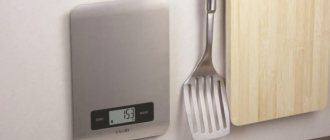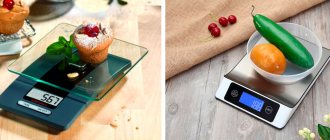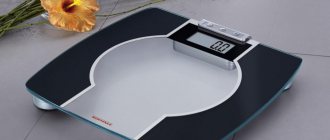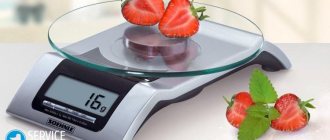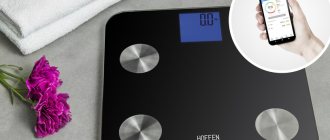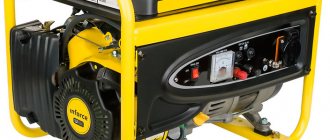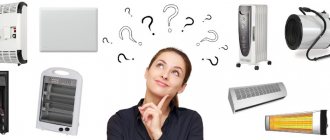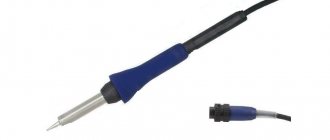Culinary scales play a different role in every home. In one kitchen, not a single meal can be prepared without them, while in another, scales are used occasionally.
In addition to its direct function - weighing food products, scales are also used for matters far from cooking. They will show a lot of jewelry, medicines, beads or yarn. It is difficult to make a choice with the variety of kitchen measuring equipment.
Types
If you know the following classification criteria, choosing the appropriate ones will not be difficult:
By mode of action:
- Mechanical;
- Electronic.
By type of design:
- with a flat platform;
- with measuring cup.
According to the availability of additional functions:
- with volume measurement;
- with calorie counting.
Based on the material used to make the body and bowl:
- plastic;
- metal;
- glass
- wooden.
In addition, it is worth paying attention to the maximum and minimum load, division price and design.
Knowing these nuances, you can make a choice without any doubts. Now in more detail about each type.
Mechanical kitchen scales
This type is familiar to everyone, it has long been used in everyday life, and is considered reliable and proven. The principle of operation is simple - under the weight of the food, the spring at the base of the housing is compressed and moves the pointer along the measuring scale.
In addition to ease of use, the mechanics have a low price. No power sources in the form of batteries or accumulators are required for operation.
Another advantage of this class is its high weight load; some models weigh up to 25 kilograms of products.
The carrying capacity of the equipment is reflected in the dimensions: the heavier the load the scales can support, the larger the area they occupy in the kitchen.
Mechanical scales are not entirely accurate and are used in conditions where 10-20 grams will not play a decisive role, as when canning or stockpiling food supplies. Over time, the spring inside stretches and accuracy continues to decrease.
Mechanical scales are giving way to electronic ones. Despite this, adherents of mechanical ones use them to this day.
On sale there are mechanical scales with a liquid crystal display, which are difficult to distinguish from electronic scales. Although they still have one function – weighing. To distinguish the mechanics, you need to press on the base, and if a spring is built into the body, you will immediately feel it.
In addition to table scales, manual scales, or steelyards, as they are also called, are used in the kitchen. This compact device is suitable for working at home, and will protect you from becoming overweight when going to the market. There is also a spring inside the steelyard, which stretches under the influence of the weight of the product suspended on the hook.
Kitchen scales - characteristics
The most common electronic kitchen scales have characteristics close to the following:
- body material – plastic, glass, metal or wood;
- non-slip rubber pads on the bottom;
- shape - flat surface or bowl;
- minimum product weight - 2 g;
- maximum weight - 5 kg;
- measurement step – 1-2 g;
- units of measurement – kilograms or pounds;
- liquid crystal display - with or without backlight, holds 4-5 digits;
- numbers on the screen – 15 mm;
- buttons – plastic, rubber, touch panel;
- Possibility of deducting tare weight;
- choice of resetting or saving values for mixing products;
- automatic shutdown;
- overload sensor;
- low battery sensor;
- powered by batteries - finger or tablet.
Accuracy of electronic kitchen scales
Sensitive sensors evaluate the load and record electrical resistance. This technology allows electronic kitchen scales to measure the weight of products with an accuracy of up to a gram. An error of 1 gram is available only with high-quality modern devices. Mechanical machines cannot handle such filigree. Their spring stretches over time, and the inaccuracy becomes greater.
Electronic kitchen scales
Electronic scales are ahead of mechanical scales in many respects. Thanks to the built-in options, they are compared to a mini-computer. All electronic devices are equipped with a liquid crystal display, which displays weight in grams and other data.
Useful options that distinguish electronic scales from mechanical ones:
- Automatic shutdown. A few minutes after they stop working, they turn off on their own. This will increase battery life since the device does not run idle.
- The opposite function is to turn on by lightly pressing the platform without using a special button.
- Resetting the container. Function for measuring the mass of a product without taking into account the capacity.
- Sequential weighing. Thanks to this option, you can gradually find out the mass of each new ingredient in a dish by resetting the previous indicator. The memory stores the received data, and after adding the last component, it displays the total weight of the finished dish.
- Select the unit of measurement: gram, kilogram, ounce and others. This option is needed for people who cook according to foreign recipes, with measurements specific to these countries.
- Counting calories. A useful application for people watching their own weight.
- Built-in timer, battery charge detection sensor and others.
The received data is displayed on the display, which in some models even shows the room temperature or the exact time.
The price of the selected device also depends on the functionality. The most primitive electronic scales only show the mass of products and are not that expensive.
However, they are more accurate than mechanical ones. Control on different models also differs, and occurs on touch or rubberized buttons.
In terms of practicality, both are worthy of attention, so you need to choose based on your preferences in appearance.
In electronic scales, the division value is from 1 to 10 grams, thanks to which they show accurate results. And the device, with a minimum error of up to 1 gram, can even weigh medicines or jewelry.
To operate electronics, you need a source of energy in the form of a battery, batteries, or a connection to the network. This is the only difference in which mechanical scales benefit from electronic scales, apart from price.
When using electronic scales, devices with strong electromagnetic radiation should be kept away. Such proximity will affect the weighing results and accelerate equipment breakdown.
When purchasing, it is worth evaluating the moisture protection provided by the manufacturer, since the quality and durability of the work depends on it. More often these are rubberized buttons and body elements.
To check the accuracy of electronic scales at the purchase stage, you can conduct an experiment. To do this, take an item with a fixed weight with you to the store; even a pack of cookies will do. When checking, place the selected weight on the surface and make sure the readings are correct. If the error is 1-2 grams, you can safely make a purchase.
Review of kitchen scales with a “load capacity” of up to 10 kg
Kitchen scales can be a good helper when preparing food according to certain recipes; they can be used when weighing various mixtures or items weighing up to 10 kilograms. This is exactly the device that came to my review, and I will try to reveal all the nuances of using this model of scales.
I bought scales here Similar models from other sellers
Main technical characteristics
- Maximum weighable weight: 10 kg
- Measurement accuracy: 1g
- Screen size: 40*18mm
- Overall dimensions of the device: 180*140*18 mm
- Weight: 300 g
- Power: 2 AAA batteries
- Case material: Stainless steel, ABS plastic
I bought the scales on the Aliexpress website, and they are delivered in a standard package with bubble wrap. The package contains a cardboard box on which there is a brief technical specification of the device.
Inside the box are the scales themselves, packed in special foam and a plastic bag. Also included in the box are brief instructions in English.
After complete unpacking, the scales themselves appear before us. The working surface of the scale, which is made of food grade stainless steel, has a special protective film. This coating is quite dense and prevents scratches throughout the entire process of assembling the scales.
After removing the protective film, the working surface is revealed, as well as the display and two control buttons, which we will return to a little later. On the other side of the scale there is a compartment for two AAA batteries, which are not included. It is also worth noting that the entire body of the scale is a working surface, and four measuring sensors serve as support legs.
When you turn on the scales with the On\Off button, the display lights up, and with the UNIT button you can select a unit of measurement, the device remembers the selected unit and when you turn it on again, this procedure does not require repetition. You can also turn on the tare function by briefly pressing the On\Off button.
It is worth noting that before weighing the scales must be placed on a flat surface. To check the accuracy of the measurement, I used calibration weights weighing from 1 to 20 grams.
When weighing, an error of 1 gram was detected, which manifests itself depending on the location of the weight on the working surface. However, it is worth noting that such an error occurred only when using a weight weighing from 1 to 3 grams. An example of erroneous weighing is shown below. The scales have weights weighing 3 grams, and the display shows 2 grams, but when the measured weight is shifted to the center of the working surface, the scales display the correct value.
The tare function works correctly, and some examples of weighing heavier items are shown below.
When ordering from the seller, you can choose one of two models with a maximum permissible weight of 5 or 10 kilograms. I purchased a 10 kg model, although when using it it turned out that in the kitchen it is quite possible to get by with the 5 kg version. Also, when ordering, you can choose one of two colors, and for residents of the Russian Federation, delivery from a local warehouse is available.
I bought scales here Similar models from other sellers
To summarize, this is an excellent model for weighing various things. Scales can be used both in the kitchen and for other household purposes. The error of this model is no more than 1 gram, which corresponds to the declared characteristics of the manufacturer. Separately, I would like to note the convenient working surface, which has no sides, which allows you to weigh large items. There are no obvious disadvantages in the device, so I can definitely recommend the scales for purchase.
Kitchen scales with bowl
A device with a bowl is convenient for measuring the mass of bulk products or liquids. To weigh large items that do not fit into the bowl, it is better to use scales with a flat platform. The housing has a special recess into which the measuring cup is securely installed.
The removable container is easier to clean, unlike scales with a built-in bowl. The unibody design is difficult to clean due to the risk of water getting into the electronics, and takes up a lot of space when stored. It is more convenient to store a device with a removable bowl by placing the device inside it.
When choosing equipment, you need to immediately decide on the volume of the bowl. There are scales with a capacity from 200 ml to 3 liters. The larger the bowl, the more convenient it is to use in a large family.
A spacious container is useful for kneading dough. And if the scales are electronic, then you can add ingredients one by one using the sequential weighing function.
Therefore, it is better to pay attention to bowls with a volume of 1 liter or more.
An important aspect when choosing is the material from which the bowl is made. There are three main materials used for its manufacture - plastic, glass and steel. Each has advantages and disadvantages:
- Plastic is a lightweight and inexpensive material that is easy to care for. Most are equipped with a plastic bowl. It is easy to clean, including in the dishwasher. However, plastic is a fragile material, and if you use it carelessly, the bowl can break, and it is almost impossible to buy an original one. Over time, this material loses its original appearance, and small abrasions and scratches appear on the surface.
- Glass is more durable. Elements of kitchen scales are made of heat-resistant and impact-resistant glass; they are heavy and durable. Glass is easy to clean, withstands high and low temperatures well, and does not absorb odors. If suddenly the bowl breaks, it will also not be possible to buy it in the store. You can only order from the manufacturer. Therefore, you need to protect the glass bowl from falling.
- Metal. Metal bowls are the most resistant to falls and damage, so you don’t have to worry about the possible replacement of this part. Another advantage is absolute resistance to temperature changes.
It seems that a metal container is better suited than others for household scales, however, there is one caveat here. When interacting with certain products, the metal may oxidize.
There are even wooden bowls, and some housewives prefer to use only these because they consider this material to be the most environmentally friendly. However, wood requires the most careful care: it is not so easy to wash, and does not tolerate long-term interaction with liquids.
It is important to remember that weighing food on an empty platform provided for a bowl is strictly prohibited. Therefore, before purchasing, you should think about whether a bowl is needed at all or whether you can get by with scales with a flat platform. The advantage of the latter is the ability to weigh in any container; all that remains is to first reset its mass to zero.
How to choose electronic kitchen scales?
Following your preferences, choose electronic scales for the kitchen according to the main criteria: functionality, quality and appearance. The requirements are related and dependent on each other: high-quality equipment made of steel has many capabilities, looks presentable and can last 10 years.
- The case of a quality product completely covers the mechanism. Assess the thickness of the cracks and gaps.
- Plastic parts reduce cost and shorten service life compared to metal and glass.
- If you choose glass, then only tempered glass. Both for the body and for the bowl.
- Wood looks expensive and requires careful care.
- Determine the shape of the scale according to your needs. It is more convenient to weigh different products in your own way. Sometimes you really need to “fit” a new element into the kitchen decor to its advantage.
- The buttons are more convenient than rubber ones. Plastic ones are short-lived, they can sink and wipe the substrate.
- Touch control is convenient and modern. Cannot tolerate wet hands.
- LCD screen – with or without backlight.
- Maximum weight – on average 3-5 kg. Professionals can withstand up to 20.
- The smaller the division step, the more accurate the result. 1-2 g is best.
- If you wish, you can take a kitchen appliance with rich functionality. Equipped with a mini-computer, they can calculate the energy and nutritional value of even complex dishes for you.
Tabletop electronic kitchen scales
When you already know how to choose electronic scales for the kitchen, decide on the shape that suits you. Focus on your needs: what do you plan to weigh more of? The simplest and most common electronic kitchen scale is a desktop model with a thin flat platform. On a surface slightly smaller than an A4 sheet, large fruits and vegetables, long spaghetti, large pieces of meat and fish are placed. The apple can be weighed directly on the platform. Chicken breast - in a plate, having previously thawed its value.
Kitchen electronic wall scales
If the choice of electronic scales for the kitchen requires compliance with a special interior, take a closer look at the options that are attached directly to the wall. They look mysterious to the uninitiated: a kind of display of unknown purpose. The weighing surface folds down from above before use, and then rises into place. Evaluate the convenience for yourself - you won’t be able to remove them and work with them on the table.
Kitchen electronic spoon scales
Another useful device, which is an electronic kitchen scale for food and more, has the shape of an ordinary spoon. The size of a dining room, up to 25 cm long, it functionally replaces conventional electronic scales. There is a display, selection of units of measure, tare deduction, auto shut-off and an overload indicator. It weighs 50 g, and the measurement limit is up to 500 g. And the accuracy is pharmaceutical - 0.1 g of error. Use it to measure:
- spices;
- medicines;
- infant formula;
- protein shakes;
- herbal preparations;
- pet food;
- wherever precise dosage is needed.
Kitchen electronic scales with bowl
Pasta, cereals, berries - for small bulk products, choose a model with a bowl, preferably a removable one. It is easy to clean, so feel free to even knead dough in it. With the built-in zeroing function, you can measure each ingredient in a recipe without removing the previous one from the container. This feature is useful in the art of confectionery, which requires precision down to the gram.
The most suitable material for electronic kitchen scales is stainless steel. This is a strong, durable, inert alloy that does not react with food, does not break and can withstand dishwasher procedures. There are also beautiful bowls made of plastic or glass. However, if the first one accidentally melts, and the second one breaks, they will have to be made to order.
Kitchen electronic professional scales
Representing the best kitchen scales, electronic mechanisms are used not only in stores and restaurant kitchens. Professional devices for the home can satisfy the needs of demanding housewives. They are distinguished from household electronic scales by:
- especially durable body materials;
- maximum load - up to 20 kg;
- increased accuracy;
- power supply from the electrical network.
Electronic scales for the kitchen - rating
Everyone has their own requirements for weights. Different manufacturers focus on reliability, advanced features, design or economy. The rating of electronic kitchen scales will help you make your choice.
- The leader in quality and reliability is Beurer
. Their model KS 48, made in Germany, is recognized as the most popular according to reviews from many evaluation portals. - The best professional scales, according to consumer reviews, are Soehnle 67080
- weigh up to 15 kg. - High-quality steel electronic scales of discreet design with touch controls, sound indication and heated platform are produced by the Caso
. - Accurate, practical and convenient are popular - Tefal BC5004V1
. - The optimal combination of functionality, quality and price - Maxwell MW-1451
. - The most convenient calorie counter - Redmond SkyScales 741S
- is controlled by an application on your phone. - Easy to clean, with a touch panel and a glass platform, electronic scales are presented by Saturn
. - The most inexpensive kitchen scales, which are functional and very beautiful, are Delfa, Mirta, Vitek, Magio
. - The most convenient and reliable spoon scales are Endever KS-513 and Vigor HX-8211
.
Kitchen scales measuring liquids
This option is not built into all scales, and is considered more of an addition than a mandatory feature. Using such a device, the volume of water or milk is measured, since only these liquids have a mass approximately corresponding to the equality 1 ml = 1 g.
To determine the volume, the liquid container is first weighed. After resetting the display, the liquid is poured in, and the volume in milliliters is immediately reflected on the display.
How convenient and useful this function is, and whether it is worth paying an additional amount of money for it, is up to the buyer to decide, because it can be easily replaced using a simple measuring cup.
Separate devices in the form of glasses have appeared on sale, intended only for weighing liquids. A sensor is built into the handle, indicating the volume of the substance in milliliters.
Kitchen scales with calorie counting function
This device is called a dietary scale. With their help, you can control the volume and nutritional value of food eaten.
Directories with a list of up to a thousand products are stored in memory. Each product is listed according to the amount of proteins, fats and carbohydrates it contains.
There are two options for entering data to calculate the value of dishes:
- Entering codes manually. The instructions are accompanied by a reference book with a list of popular products, each assigned a code. The device has a keypad on which you need to press the required combination of numbers from the directory.
- Selecting products from an electronic menu. Such a device is easier to use, and therefore much more expensive. To select a product, just find it in the electronic list.
Otherwise the operating principle is the same. The product is placed on a bowl or platform and a selection is made from the menu. Now the electronic display shows the mass of the product, calorie content, and the amount of proteins, fats and carbohydrates in terms of a given weight.
If the weight reset function is provided, after adding all the ingredients one by one, it will show the nutritional value of the whole dish.
Some models have additional memory capabilities when a calorie limit is set for a dish. The scale will notify you if the specified limit is exceeded.
A useful feature in dietary scales is the ability to add additional products not listed on the menu to the list. Another option is to add an item you already have, but with a different calorie content, since the same foods have different nutritional values depending on how they are prepared.
How to use kitchen electronic scales?
Using electronic kitchen scales is very simple:
- Insert batteries and turn on the scale using the ON/OFF button. The “0” symbol will light up on the screen.
- Determine the units of measurement: kg/lbs or g/oz, depending on model. The mechanism will remember your choice.
- If you are weighing food in a plate, place the empty container on the scale and press the TARE button. Its gravity will be reset to zero and the weight of the pure product will be shown.
- Place the item to be weighed exactly in the center of the platform.
- The weight of the product will appear on the display.
- When finished, turn off the scale. If you forget, they will turn off on their own after a few minutes.
How to set up electronic kitchen scales?
To minimize the error of kitchen electronic scales, it is necessary to calibrate them occasionally. Fine-tuning the meter checks the reference load and compares weighing accuracy. The instructions for each model describe the steps in detail, but the order is similar everywhere.
- Turn off the electronic scales.
- Hold the button indicated in the manual for up to 30 seconds until the CAL value appears.
- Establish the mass of a reference object, the value of which you know exactly.
- After a couple of seconds of weighing, the message PASS will appear - calibration is complete.
- The word FAIL means failure - repeat the calibration from the beginning.
We choose electronic kitchen scales for their high accuracy and sensitivity. In return, they require careful treatment. Whatever model you own, there are 10 general recommendations for caring for them.
- Try not to drop it, otherwise you won't be able to count on accuracy.
- Press the buttons gently, do not press hard.
- Never get the scale wet. Spilled liquid generously will ruin the electronic components.
- Wipe the housing with a damp cloth for cleaning at home.
- When it gets really dirty, take a wrung out sponge with a drop of dish gel. Make sure that water does not get into the cracks. When finished, wipe dry.
- Keep the device away from a hot stove.
- The equipment reacts to electromagnetic radiation. To avoid interference, keep kitchen electronic sensitive scales away from your computer or microwave.
- Do not place mats before weighing. For correct operation you need a flat horizontal surface.
- If you rarely turn on the meter, store the batteries separately.
- Do not disassemble the kitchen scale yourself, but use it for a long time and with pleasure.
Kitchen scales with a load of up to 5 kg
There is a variation in the maximum load of different types of devices. This difference depends on the type of scales and the purposes for which they are purchased.
If the device is used only for weighing ingredients for dishes, then the limit can be limited to 2-3 kg. And to calculate the mass of heavier products, for example, vegetables and fruits, it is better to choose a device with a larger load.
Most household measuring devices, mechanical and electrical, are designed to weigh loads up to 5 kilograms. This is the golden mean, optimal for home use. The maximum permissible weight is stored in the device’s memory, and no matter what load is placed on the platform, the display will not show more than this figure.
In addition to the fact that it will not be possible to find out the real mass of an object that exceeds the limit, such an experiment can damage the equipment.
And to avoid accidental overload, the scales are equipped with a special indicator that notifies the user of an error.
Important! Tabletop scales, regardless of the operating mechanism, must have stable legs, preferably rubberized ones.
Thanks to this, the device is installed level and without distortion, otherwise the weighing results may differ greatly from the truth.
Wall kitchen scales
There are both electronic and mechanical scales on the wall. In addition to its convenient location and compact storage, the scales have an original appearance, so they will decorate the kitchen interior.
And electronic scales in this position can additionally perform the function of a thermometer or a clock. For wall mounting, use a special bracket or a factory hinge on the back. There are also many installation options, and if you hang it on the railing hooks, you don’t have to make a hole in the wall.
There is a separate type of scale designed for wall use only; it does not have a stable base with legs, but does have a pull-out platform for placing items.
After use, all moving parts fold neatly back into a compact design.
